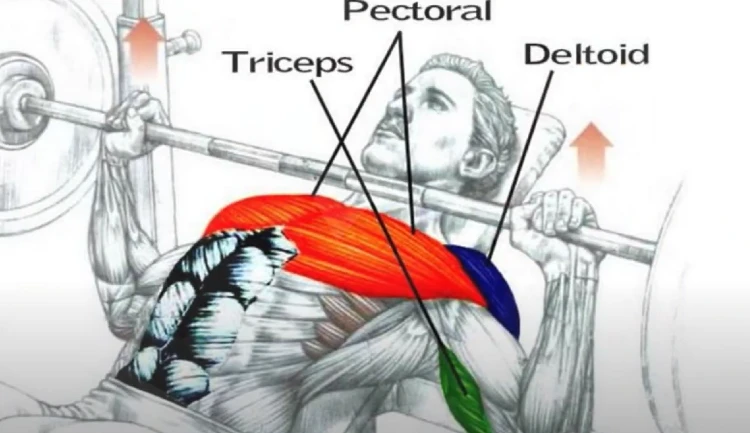
With bench press, muscles worked include the chest and triceps as many may assume, but surprisingly there’s quite a bit of shoulder and back involvement as well.
Of course, the lifters can use the incline vs decline vs flat bench to target different muscles, and due to a greater ROM (range of motion) dumbbell presses can be even better than the barbell bench press deepening on an individual’s goals.
So before you have the next chest day, check to see the muscles are worked in various types of bench presses (angles and grip widths), if it targets the chest or triceps more, the best ways to improve your bench press, and see if the dumbbells is better for your training goals.
Flat Bench Press: Muscles Worked During the Exercise
The flat barbell bench press is a compound exercise focusing on the upper body, involving the pectoralis major (chest muscles), triceps, and front deltoids (shoulder muscles), all working together to push the bar upward.
You can perform a bench press using barbells, dumbbells, and free weights, with the barbell bench press being one of powerlifting’s big three alongside back squats and deadlifts.
The movement serves to not only increase the size and strength of the primary movers, but also to enhance stability in any other pushing movements such as the overhead press. It also recruits other muscle groups known as stabilizers muscles which include erector spinae, rotator cuffs and lats to work together with the primary movers to yield the greatest force in a well-orchestrated movement.
Chest Muscles (Upper Pecs, Lower Pecs)
The chest muscles are one of the fundamental primary movers for the bench press and the main reason why many lifters do this movement—to grow massive chests and shoulders. They are activated the most in two stages of the press; the first being during the descent of the bar, and the second when at the bottom or end phase before pressing the bar back up.
It should be noted that both pecs are stimulated twice as much as on the descent compared to the ascension phase of the movement.1 They are therefore employed highly when bar is being slowly lowered towards the chest making this phase critical for chest growth and an indication of potentially weak pecs due to lack of strength at the bottom phase of the lift .
Chest muscles are divided into upper (sternocostal head) and lower pec (clavicular head), and depending on what variation is being performed, one will be targeted more than the other.
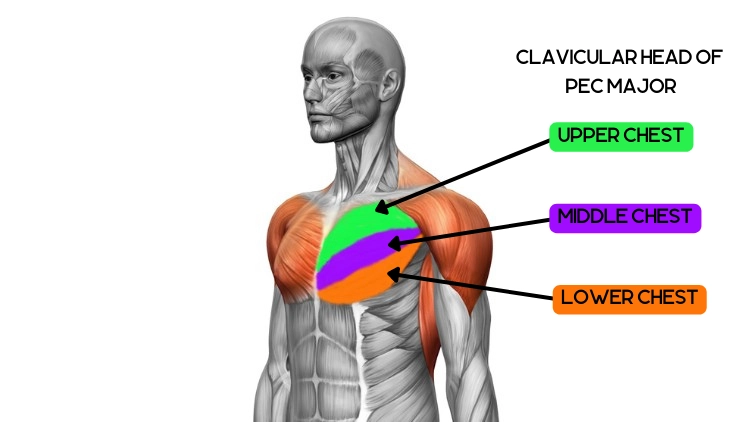
Source: Science Photo Library via Canva.com2
Shoulder Muscles (Front Deltoids, Rotator Cuff)
Chest press works the shoulder muscles, specifically the anterior or front deltoids which are recruited mostly in the mid-range part of the movement.
Front deltoids—Front deltoid’s role in the bench press as a prime mover is to position the arms straight overhead from the front of the chest which is known as shoulder flexion. The chest and triceps have varying levels of activation during descent and ascent; the same is not true with the shoulders.
Front deltoids are activated equally throughout lowering and pressing the bar with the peak activation being close to the middle of the bar path regardless of whether the bar is being lowered or being pressed up.
Rotator cuff—the rotator cuff is an important muscle that ensures the stability of the shoulder joint in the movement. It is a common site for injury when the bench press is executed with poor form, when they are weak and due to flexibility issues with the shoulder.
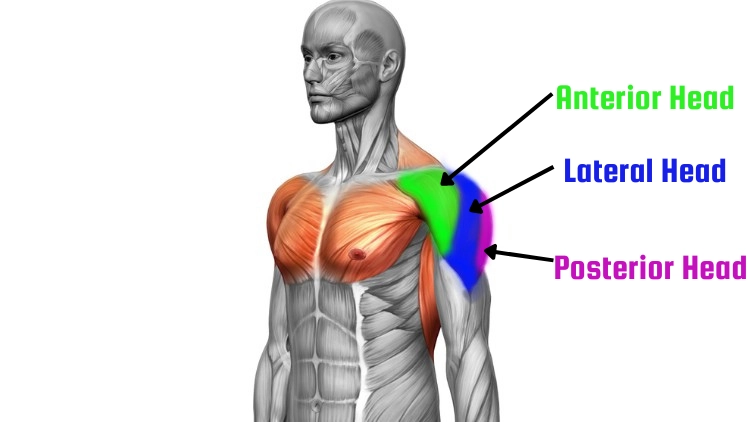
Source: Science Photo Library via Canva.com2
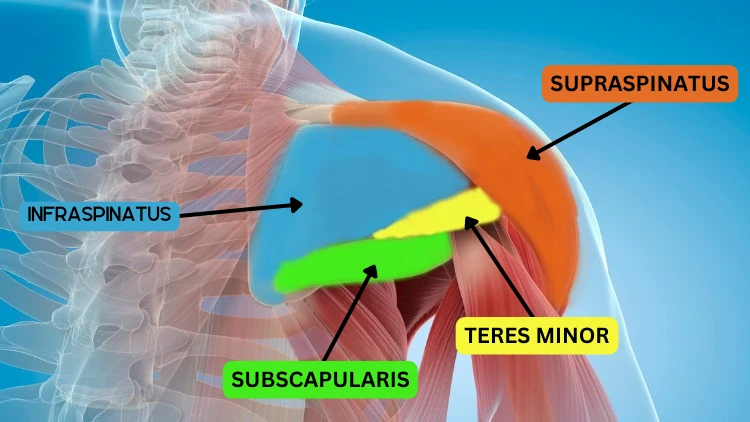
Source: Science Photo Library via Canva.com3
Arm Muscles (Triceps, Biceps)
The triceps are one of the primary movers of the bench press movement, but the biceps play the role of a secondary muscle.
Triceps—the triceps muscles consist of three heads, two of which are used in the bench press and these are the lateral and medial heads. They are activated mostly during the lockout phase when the limbs are fully extended and their role is to extend the elbow—transitioning them from bent to locked position.
Triceps muscles are inactive during the descent but are only recruited on the press up to the lock out.
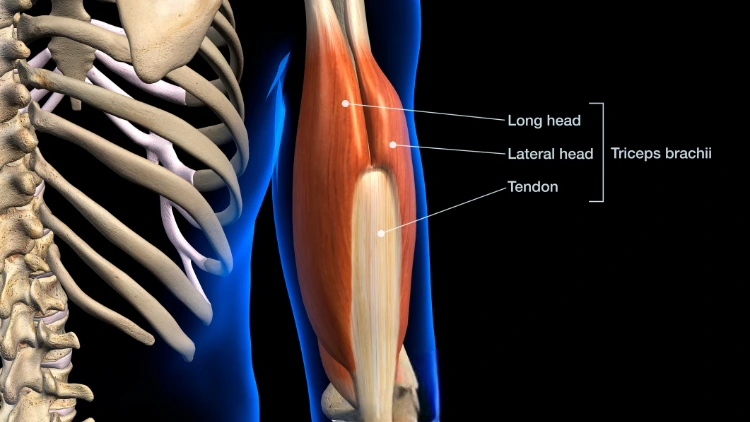
Source: Hank Grebe via Canva.com4
Biceps—the biceps muscles attach at the shoulder scapular (blades) to the radius which is a bone of the arm and they serve the purpose contracting the arm at the shoulder and at the elbow. Although not a primary mover, the bench press can still engage the biceps, which are among the hardest muscles to grow.
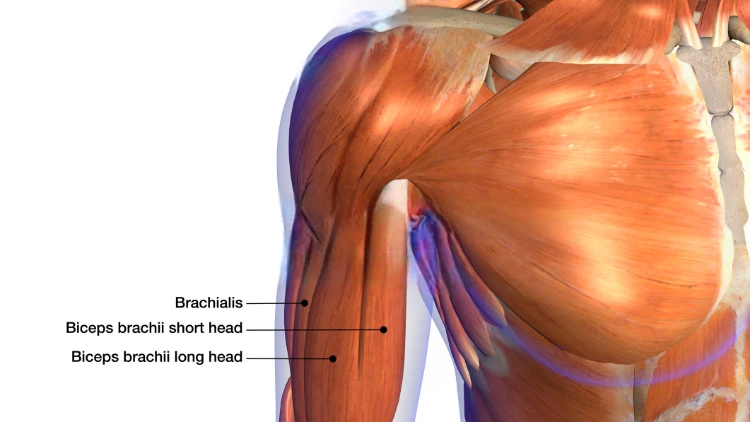
Source: Hank Grebe via Canva.com5
Back Muscles (Erector Spinae, Lats, Rhomboids, Traps, Serratus Anterior)
The back muscles play a stabilizing role during the bench press and provide a solid, firm support for the movement.
Erector spinae, lats, rhomboids and traps—the back muscles are used in two ways when bench pressing, the first being when the lifter is placing themself into an arch position for a bench press; to do this, lifters retract the shoulders and this is facilitated by a combined action of the lats, erector spinae, rhomboids and traps.
Their second use comes during the descent part of the bench press which is essentially a row. The row is a pull exercise that targets the back muscles which is mimicked when the bar is pulled towards the chest.
Benching recruits these muscles allowing the bar to be lowered in a controlled fashion and stop it from falling over due to gravity. Therefore having a strong back is key to having a strong bench press.

Source: Hank Grebe via Canva.com6
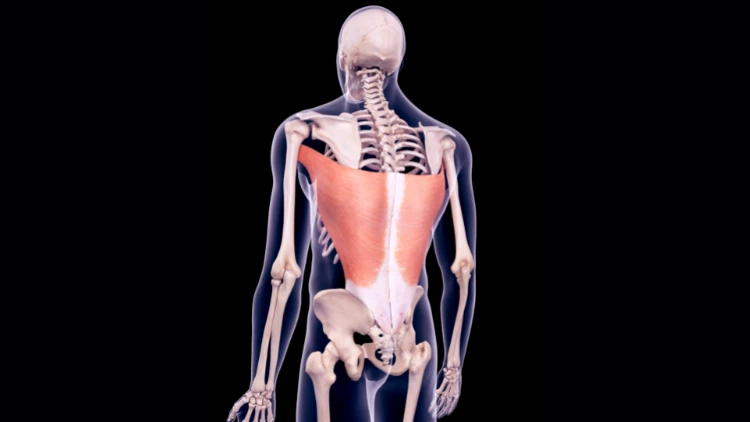
Source: Science Photo Library via Canva.com7
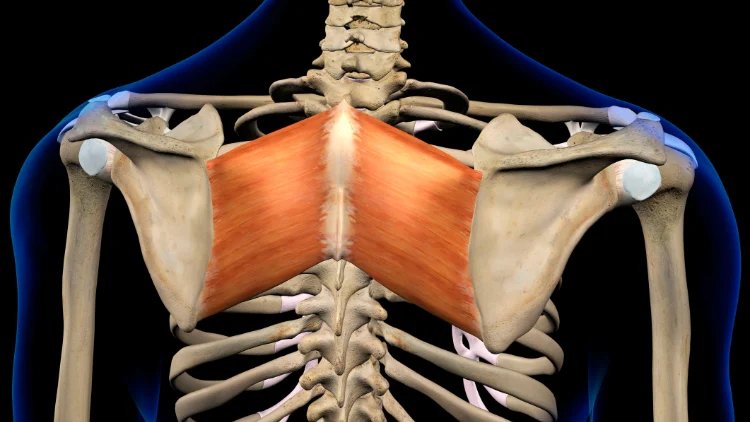
Source: Hank Grebe via Canva.com8
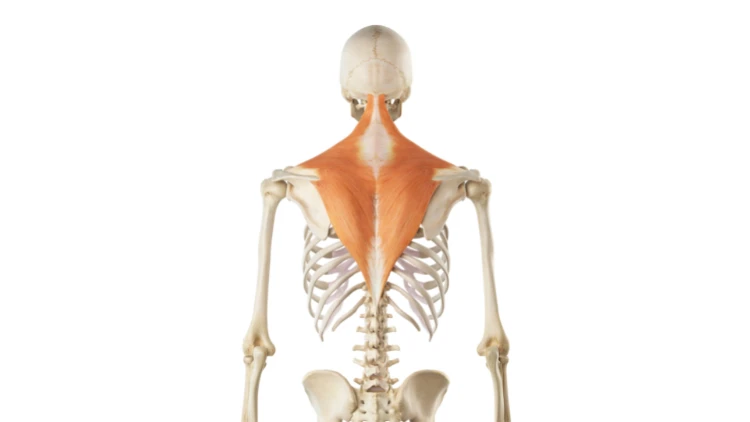
Source: Science Photo Library via Canva.com9
Serratus anterior—these fan shaped muscles help give support to the shoulder girdle (muscles that attach to the shoulder blades) during pressing and also takes some of the stress off the rotator cuff.
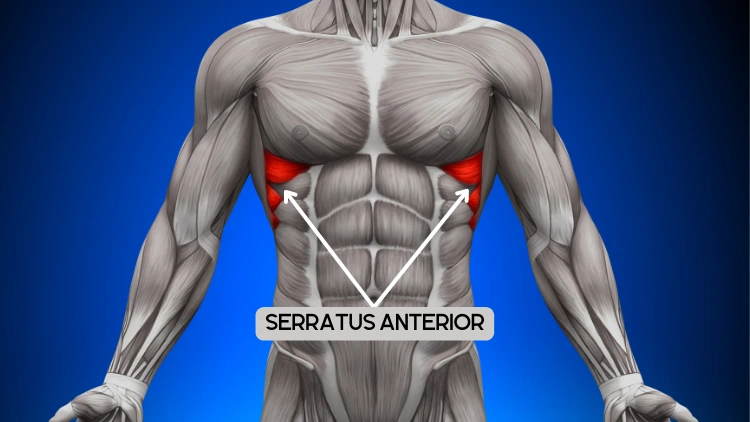
Source: decade3d via Canva.com10
Bench Press Variations & Their Primary Muscles Used (Incline vs Decline vs Flat Bench Press)
The different bench variations target different muscle groups due to the position of the torso or the grip resulting in some groups being activated more depending on the variation.11 Variations of the bench press include incline, decline, close grip, and dumbbell bench presses, all of which can be integrated into a bench press pyramid program.
What Muscles Are Worked by the Flat Bench Press?
The flat bench is the most commonly used variation and is frequently included in a 4-day workout split routine. As a result of the horizontal position of the torso when performing this exercise, the chest, triceps and shoulder muscles are all activated serving the roles of primary movers.
Muscles Emphasized on Flat Bench Press (Upper Pecs, Lower Pecs)
Both lower and upper pecs are worked and activated evenly during the flat bench press. The flat bench press provides a much more efficient pressing angle for the chest muscles than the incline bench press since the line of force passes through the center of the chest muscles making it an excellent chest builder.
For this reason, most lifters are able to haul heavier weight in the flat bench press when compared to the incline bench press.11 This angle of the flat bench press exerts significant amounts of stress on the pecs with many torn pecs in bodybuilding being the result of heavy flat bench pressing.
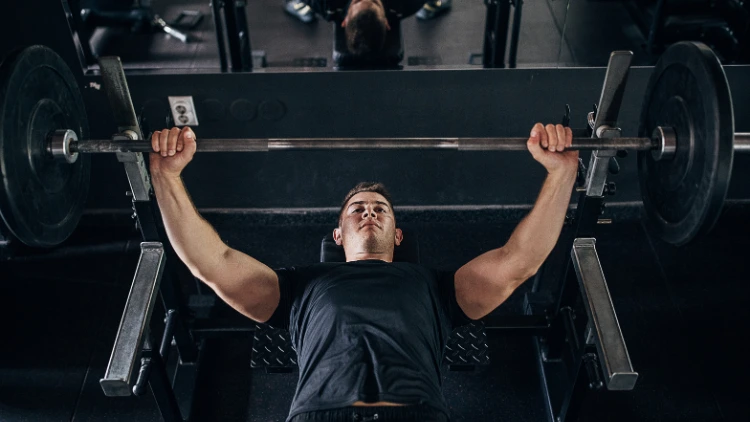
Source: Hirurg via Canva.com12
In addition the muscles emphasized, these muscles are also used to complete the movement:
- Triceps
- Front deltoids
- Erector spinae
- Lats
- Rhomboids
- Traps
- Serratus anterior
Bench Press: Muscles Worked in Incline Bench
The incline bench press is done with the lifter lying on the bench raised to an angle, ideally at 30 degrees with the torso being raised parallel to their hips resulting in a shift in the angle of resistance, subsequently activating the primary movers in a different muscular activation configuration, but the primary movers remain the same—the chest muscles, the front deltoids and triceps.
Muscles Emphasized on Incline Bench Press (Upper Pecs)
When it comes to incline bench press, muscles worked are the upper and lower pecs and front deltoids. Because of the angle, these muscles are stimulated in a different way compared to the flat bench press and the triceps have a reduced role.
A study that was conducted in 2010 demonstrated that the best incline angle for each muscle as:13
- Lower pec—0 degrees
- Upper pec—44 degrees
- Front deltoid—28 degrees
Upper pecs—the incline bench press will target the upper pecs (upper portion of the pec muscles) more than the lower pecs with a 30 degree angle sufficient to elicit this difference in activation.14 Reason being that due to the incline of the bench, the upper pecs are directly below the line of force.
This difference in superior upper pec activation has been shown to significantly contribute to more upper pec hypertrophy (muscle growth) compared to other variations of the bench press.15
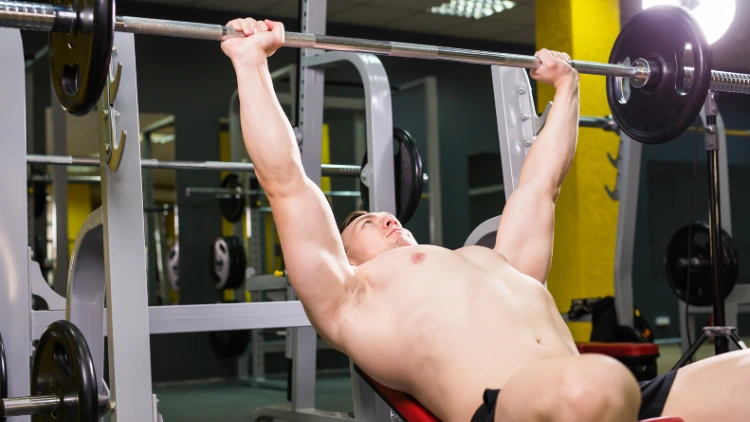
Source: 15Изображения пользователя Tatiana via Canva.com16
In addition the muscles emphasized, these muscles are also used to complete the movement:
- Triceps activation is 50% less in this version of the bench press when compared to the decline and flat bench press.17
- Front deltoids
- Erector spinae
- Lats
- Rhomboids
- Traps
- Serratus anterior
Bench Press: Muscles Worked on Decline Bench
Decline bench is performed on a bench that is placed on a 15-30 degree decline and is an excellent exercise to target the lower pecs. By placing the torso in a declined slope, the lower pecs are greatly activated as the weights are pressed away from the body.
Muscles Emphasized on Decline Bench Press (Lower Pecs, Upper Pecs)
As the weight is being pressed in the upwards phase of the movement, the lower pecs have the role to extend the arms with assistance from the other primary muscles, the triceps and front deltoids. During the transition to the downward phase, when the weight is heading back to the chest, the lower pecs work to contract the arms.
The decline bench press has been shown to have a greater activation on the lower pecs, but the same level of activation of the upper pecs has been found with both incline and decline bench presses.18 The upper pecs are therefore still stimulated in this exercise.
Because most of the load is handled by the lower pecs, this movement is less stressful on the back and shoulders.
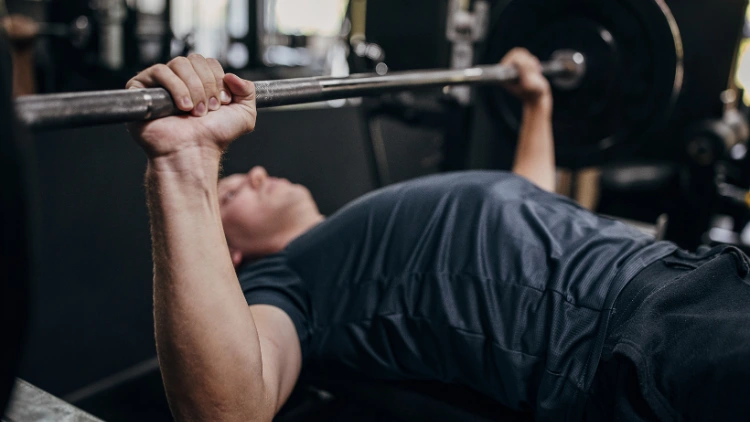
Source: Hirurg via Canva.com19
In addition the muscles emphasized, these muscles are also used to complete the movement:
- Triceps
- Front deltoids
- Erector spinae
- Biceps
- Lats
- Rhomboids
- Traps
- Serratus anterior
Bench Press (Muscles Worked With Close Grip)
Another variable that can be changed other than the other angle of the torso is the width of the grip which is generally about shoulder width or slighter inside of this width—known as the close grip bench press.
Muscles Emphasized on Close Grip Bench Press (Triceps, Upper Pecs)
Triceps—with the narrow or close grip bench press, muscles worked are more of the triceps than the chest muscles and front deltoids.20
A narrower grip alters the path of the bar with the end of the bar path being below the sternum which is a slightly lower position than that of the conventional bench press. The close grip bench press is a great triceps exercise to include for those curious about the reason why their arms won’t grow, as it provides superior triceps activation.
Conversely, the wider a lifter grips the bar, the higher the activation of the chest muscles—about 2 times the shoulder width has been shown to activate the chest muscles than it does the triceps and shoulders.21
Upper pecs—the close grip bench press activates the upper pec chest effectively, a study conducted in 1995 showed that this type of movement increased activation in the clavicular head of the pectoralis major.22 This is the section of the pecs closest to the shoulders and collarbone.
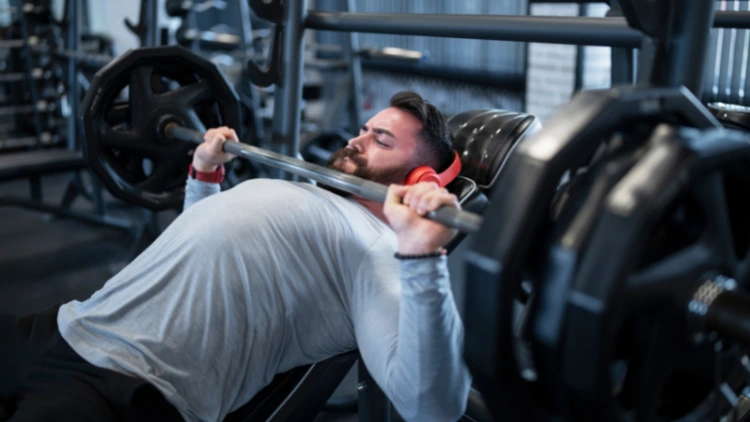
Source: ArtistGNDphotography via Canva.com23
In addition the muscles emphasized, these muscles are also used to complete the movement:
- Front deltoids muscles are not recruited much in this exercise22
- Erector spinae
- Lats
- Rhomboids
- Traps
- Serratus anterior
Dumbbell vs Barbell Bench Press: Muscles Worked
While performing the bench press with the barbell is an effective exercise for building the upper body, using the dumbbell can provide even more benefits and work the primary movers in different ways and through a greater ROM (range of motion), which is why the dumbbell is even better.
With that being said, the dumbbell bench press has the same primary movers as the barbell bench press; chest muscles, front deltoids and triceps muscles. In addition to this, the side delts are also involved in the movement.
More than often, the barbell is the go to staple for gym bros looking to bulk up on the chest, often shying away from dumbbells since the barbell bench press allows the lifter to load maximum amount of weight also known as raw stimulus magnitude. Here’s a further explanation of RSM or raw stimulus magnitude as well as SFR or stimulus to fatigue ratio.
This quality of barbells allows the lifter to build more strength. Dumbbells however offer something the barbell doesn’t, they are a unilateral exercise (each side lifting its own weight) making them beneficial to address muscle imbalances.
The dumbbell allows the lifter to achieve a much longer range of motion (ROM) than can be afforded with barbells which results in increased muscle activation. When bench pressing with dumbbells, there is no barbell to inhibit the arms from descending lower which means the pecs can go into a deeper stretch.
Dumbbell bench press has been shown to activate the pecs and the biceps much more than the barbell due to the increased ROM and weighted stretch experienced.24
Weighted stretch (stretch-mediated hypertrophy) occurs when the sarcomere (contractile unit of a muscle fiber) experiences stretching beyond a threshold and not when the actual muscles are stretched. There are three factors that influence muscle growth including mechanical tension, metabolic stress and damage caused to the muscle.
Mechanical tension is the load a muscle bears when lifting and the resultant force produced—the amount of tension that muscle has the ability to produce varies across its length and is known as length tension relationship.25
The length under which a muscle can be trained will be a determining factor in how much tension can be placed on it—tensile strain on muscles when loaded may cause muscle growth.26 The dumbbell bench press affords this.
The instability of holding the weights will elicit the lifter to be more attentive to ensuring the weights remain under control and slowing the descent down which will increase the time spent under tension encouraging muscle growth.
These attributes make dumbbells an attractive variation for those looking to increase upper body strength. Rather working on only dumbbells or barbell bench presses, the two should be combined to get the best of both worlds as a case in point; barbell bench presses activate the triceps more than dumbbell bench presses.
Therefore, combining both will create a more well-rounded workout and assist lifters in avoiding getting stronger but not bigger.
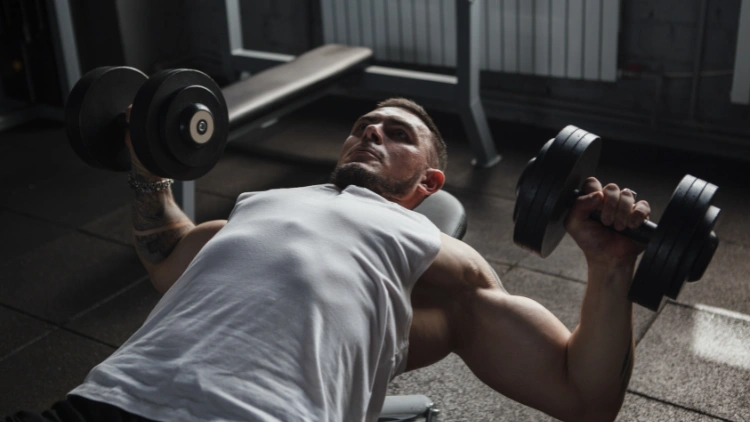
Source: madproduction via Canva.com27
Dumbbell bench presses, similar to barbell bench presses, can be performed on flat, incline, or decline benches. The incline dumbbell press is particularly prominent in programs like PHUL hypertrophy training and 5-day powerbuilding split.
Are the Muscles Worked in Bench Dips Same As the Bench Press?
Bench dips, often referred to as the upper body equivalent of back squats, are a compound exercise targeting the upper body, similar to the bench press. They engage similar muscle groups (chest, triceps, and shoulders) but with varying intensity and recruitment patterns. Bench dips activate the lower pecs more than the bench press.
The bench press targets these muscles evenly when done on a flat bench press. The only scenario where the lower pecs are targeted is in the decline bench press.
Lifters tend to be stronger in bench press than they would be on bench dips.
Bench dips are a functional movement that can carry into daily activities such as getting up from a chair, making them versatile and should be included in a workout program. Incorporating bench dips and thereby increasing training volume can help individuals with bad chest genetics overcome their limitations and enhance chest muscle growth.
Chest vs Triceps: Which Muscle Does Bench Press Target More?
The chest and triceps are one of the three primary movers of the bench press, with the front deltoids being the third; but which muscles are targeted more depends on the variation of the bench press.
With a medium or wide grip bench press, muscles worked are the chest and front deltoids because the triceps are engaged to a lesser extent in lifting the weight.28
When the grip is shoulder width or even less as in close grip bench press, the triceps are more activated in the movement contributing to almost 40% in hauling the weight compared to just over 60% for the chest and shoulder muscles (front delts) combined.
6 Benefits of the Barbell Bench Press
The barbell bench press offers a myriads of benefits other than developing upper body strength; these include building stronger bones and helping in weight loss—a list of all the benefits appears below:
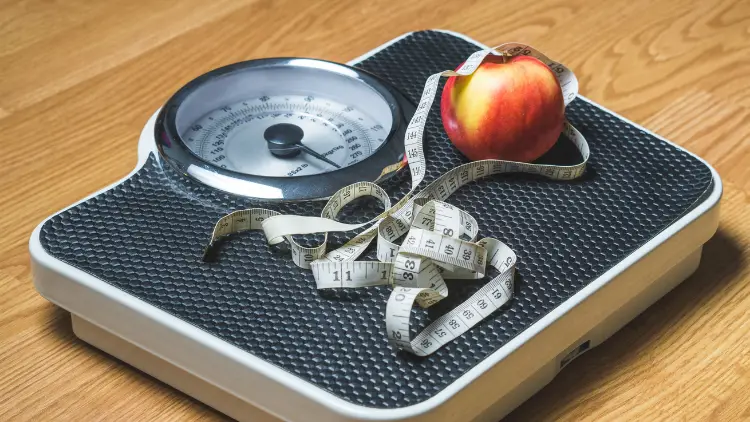
Source: TeroVesalainen from Pixabay29
- Increased muscle mass and strength—the bench press is an excellent compound movement that packs on upper body muscle and strength and is staple for any serious lifter looking to make significant gains. The bench press is a beneficial exercise to include during a cut for those curious about muscle loss during a cut because it promotes significant growth with minimal fatigue.
- Calorie burner—bench press is taxing and strenuous on the body and as a result burns a significant amount of calories.
- Weight loss—building muscle from bench presses increases the body’s basal metabolic rate since muscle needs energy to maintain, which expends calories even after the workout contributing to weight loss.30
- Mental health—physical exercises done regularly such as bench press enhances mood while improving sleep and reducing anxiety.31
- Bone health—as a result of the stress placed on the body to complete the movements, bone density improves due to the body’s adaptation to the exercise. A 2014 study demonstrated that including the bench press in workouts improved bone health and was a remedy for osteoporosis; a condition where the bones become weakened and fragile and prone to breaking.32
- Improved physique—in addition to building bulging chest muscles, the triceps muscle is also stimulated to hypertrophy and as this muscle makes up more than 60% of the arm, the arms have increased mass and appear more toned.
How To Bench Press Correctly (Tips to Improve Your Bench Press Form)
Bench pressing correctly with good form has many advantages, including making the movement safer to prevent injuries especially to the shoulder, addressing imbalances and weaknesses and will go a long way in improving bench press numbers by placing the body in the most efficient mechanical advantage to execute the press. Below are 8 steps to be taken to achieve this.
Step 1: Feet Placement
The feet provide a stable platform to drive the weight up with maximum power. Try as much as possible to plant the feet back towards the butt to allow them to generate force from the ground, through the body and into the bar.
Step 2: Bar & Torso Position
This is unique to individuals of different body sizes; however the lifter should place their back far enough to be below the bar such that it is easy to unrack but not excessively such that the pegs are hit when unracking.
Step 3: Shoulder Blades & Back Arch
Once under a bar in an optimal position, squeeze the shoulder blades together as attempting to crush an object between the blades. This protects the shoulders and pushes the upper back into the bench to provide a stable platform to press.
By squeezing the shoulders, the lower back will naturally arch, helping to maintain a neutral spine and maintain tension in the upper back and shoulders.
Step 4: Grip
The barbell should be grabbed tightly holding it as far down the palm as is possible (in the meaty part), ensuring the wrist does not bend but remains neutral to provide force optimally. If the bar is held too high in the hand, the wrist will bend.
Grip width will be dependent on what muscle needs to be emphasized and arm length. Typically, those with longer arms grip wider while those with shorter arms grip narrower.
Also, narrow grip recruits more of the triceps, wider grips target the pecs more.
Step 5: Unracking The Bar
Inhale deeply, ensuring that the whole torso is tight and under tension. There should be no wasted energy on unracking the bar, it should be at a height where it can just be popped off.
If this is not possible, then it would be wise to recruit some help in the form of a training partner.
Step 6: Lowering The Bar
Take one more breath before lowering the bar to help maintain tension by bracing the abdominal wall and imagine bending the bar; this will facilitate the correct elbow tuck that activates the lats and preserves the shoulder from additional stress.
Step 7: Touching The Chest
The point where the bar should touch during bench press varies significantly based on the lifter’s grip and arm length.
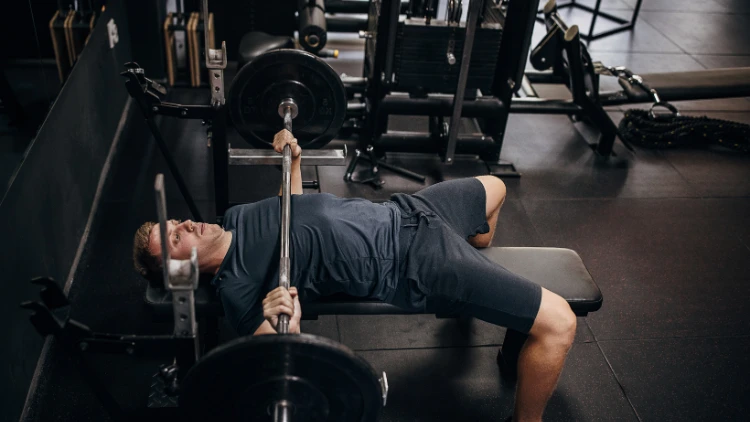
Source: Hirurg via Canva.com33
For many lifters, the bar should touch in the region below the nipples. But regardless of where the bar touches the chest, there should be consistency and not have varying touch points.
Step 8: Use The Leg Drive
Upon the bar making contact with the chest, tighten the glutes and commence pressing the bar up using power from the legs by imagining pushing the floor away. Utilizing bench press leg drive is essential for lifting heavier weights and maintaining tightness and tension in the torso.
As you press the bar up, exhale forcefully, ensuring the bench press bar path follows a reverse ‘J’ trajectory, guiding the bar towards your head. Proceed back to step 6.
Below are tips to help maintain good form and technique in the press:
- Inhale before lowering the bar and exhale while pressing the bar from the chest.
- Do not bounce the bar off the chest.
- Maintain the same touching point for the bar.
- Do not flare the elbow by imagining bending the bar in a U shape.
- Squeeze shoulder blades and maintain them.
- Ensure you wear suitable footwear such as these Adidas powerlifting shoes for your workout.
The barbell bench press is a superior compound movement with different variations. With this bench press, muscles worked change due to the angle of the torso and grip. However the dumbbell bench press offers many advantages over its barbell counterpart which is why dumbbell is even better—combining the two makes for an all rounded upper body workout.
Frequently Asked Questions
How Many Sets & Reps of Bench Should I Do per Session or Week?
To build chest muscle, aim to bench press at least twice a week completing 15-20 sets and ranging these sets in 8-12 rep range with a load of approximately 65-75% of the maximum weight that can be lifted with 1 rep also known as the 1RM.
How Often Should I Bench Press?
It depends on the training goals—a lifter should target bench pressing at least twice a week if they are looking to build and grow chest muscles, but can push this number to 3 as long as the muscles are given 48-72 hours to recover.
Is Bench Press the Best Workout?
Bench press is easily one of the the most efficient and effective workouts that can lead to upper body strength and mass for the lifter. It is also one of the big 3 compound movements in which the strength of powerlifters is gauged.
Does the Overhead Press Target the Same Muscles As Bench Press?
The overhead press whose primary target is the shoulder muscles incidentally employs the same muscles that are used in the bench press; chest muscles, deltoids and triceps. However, the main difference is the way the muscles are targeted—bench press is performed while laying down and the overhead press is executed in a standing position.
Should I Do Push Ups To Improve My Bench?
Pushups can certainly improve the bench press and any lifter looking to increase the bench press should include push ups on a regular basis and into their routine. This is because pushups facilitate the healthy functioning of the shoulder joint, increase endurance and work capacity, help build chest, triceps and shoulder muscle.
How Does Grip With Affect Muscles Worked in Bench Press?
Grip width affects positioning of the elbow and range of motion or path which the bar travels and resulting variations will either target the chest or triceps muscle more. Wider grip places the focus on the chest muscles while the narrow grip will stimulate the triceps muscle more.
Barbell Bench Press vs. Dumbbell Bench Press: Which Is Better?
It depends on the training goals of the lifter.
Bench pressing with dumbbells allows for increased activation of the chest muscles while the barbell targets the triceps muscles more. Dumbbell bench pressing affords a longer range of motion making it ideal for muscle growth.
Can You Grow the Chest Muscles With Dumbbell Bench Press?
The dumbbell bench press is an excellent regimen for chest muscle growth and actually activates the chest muscles much more than the barbell bench press. It is a better choice compared to other chest building exercises.
Is the Dumbbell Bench Press More Challenging Than the Barbell Bench Press?
Dumbbell bench press is harder to perform because of a harder set up and due to being less stable, making it more challenging to perform. In addition, there is no compensation from the stronger arm making it more of a tough exercise to complete.
References
1Duffey, M. J. (2008, August 21). A biomechanical analysis of the bench press. Retrieved 2022, from <https://etda.libraries.psu.edu/catalog/8894>
2Science Photo Library. “The muscles involved in standing biceps curl. The stabilizing muscles are highlighted.” Canva. Accessed 12 April 2023. <https://www.canva.com/photos/MADmTGwAFbo-the-muscles-involved-in-standing-biceps-curl-the-stabilizing-muscles-are-highlighted-/>
3Science Photo Library. “”Shoulder muscles.” Canva. Accessed 12 April 2023. <https://www.canva.com/photos/MADmTDg8VA4--shoulder-muscles/>
4Hank Grebe. “Labeled Anatomy Chart of Shoulder, Elbow and Triceps Muscles in Skeleton on Black Background.” Canva. Accessed 14 April 2023. <https://www.canva.com/photos/MAEJnzTxmJU-labeled-anatomy-chart-of-shoulder-elbow-and-triceps-muscles-in-skeleton-on-black-background/>
5Hank Grebe. “Labeled Anatomy Chart of Neck and Shoulder Muscles on White Background.” Canva. Accessed 15 April 2023. <https://www.canva.com/photos/MADZASGJL7w-labeled-anatomy-chart-of-neck-and-shoulder-muscles-on-white-background/>
6Hank Grebe. “Male Erector Spinae Back Muscles in Isolation on Skeleton.” Canva. Accessed 12 April 2023. <https://www.canva.com/photos/MAD8-XkZ3xQ-male-erector-spinae-back-muscles-in-isolation-on-skeleton/>
7Science Photo Library. “F017/1255.” Canva, 20 April 2019. Accessed 13 April 2023. <https://www.canva.com/photos/MADq3vbyn-k-f017-1255/>
8Hank Grebe. “Male Rhomboid Major Back Muscles in Isolation on Skeleton.” Canva. Accessed 15 April 2023. <https://www.canva.com/photos/MAD9YMm5tt4-male-rhomboid-major-back-muscles-in-isolation-on-skeleton/>
9Science Photo Library. “”Human trapezius muscles.” Canva. Accessed 13 April 2023. <https://www.canva.com/photos/MADmTLHptgU--human-trapezius-muscles/>
10decade3d. “Serratus Anterior – Anatomy Muscles.” Canva, 20 April 2019. Accessed 13 April 2023. <https://www.canva.com/photos/MAC_UoPgDPM-serratus-anterior-anatomy-muscles/>
11Atle Hole Saeterbakken, D.-A. M. (2017, June). The Effects of Bench Press Variations in Competitive Athletes on Muscle Activity and Performance. Retrieved 2022, from <https://www.ncbi.nlm.nih.gov/pmc/articles/PMC5504579/>
12Hirurg. “Bench press training.” Canva. Accessed 15 April 2023. <https://www.canva.com/photos/MAFZ-nDXziA-bench-press-training/>
13Arthur A Trebs, J. P. (2010, July). An electromyography analysis of 3 muscles surrounding the shoulder joint during the performance of a chest press exercise at several angles. Retrieved 2022, from <https://pubmed.ncbi.nlm.nih.gov/20512064/>
14Jakob D Lauver, T. E. (2015, March 23). Influence of bench angle on upper extremity muscular activation during bench press exercise. Retrieved 2022, from <https://pubmed.ncbi.nlm.nih.gov/25799093/>
15Suene F N Chaves 1, V. A.-J.-C. (2020, August 1). Effects of Horizontal and Incline Bench Press on Neuromuscular Adaptations in Untrained Young Men. Retrieved 2022, from <https://pubmed.ncbi.nlm.nih.gov/32922646/>
16Изображения пользователя Tatiana. “Weightlifter at the Bench Press Lifting a Barbell on an Incline Bench.” Canva. Accessed 15 April 2023. <https://www.canva.com/photos/MAEsXp2yuGA-weightlifter-at-the-bench-press-lifting-a-barbell-on-an-incline-bench-/>
17Atle Hole Saeterbakken, D.-A. M. (2017, June). The Effects of Bench Press Variations in Competitive Athletes on Muscle Activity and Performance. Retrieved 2022, from <https://pubmed.ncbi.nlm.nih.gov/28713459/>
18David Rodríguez-Ridao, J. A.-V.-F. (2020, October 8). Effect of Five Bench Inclinations on the Electromyographic Activity of the Pectoralis Major, Anterior Deltoid, and Triceps Brachii during the Bench Press Exercise. Retrieved 2022, from <https://www.ncbi.nlm.nih.gov/pmc/articles/PMC7579505/>
19Hirurg. “Bench press exercise.” Canva. Accessed 15 April 2023. <https://www.canva.com/photos/MAFYc730I8k-bench-press-exercise/>
20Robert G. Lockie, S. J.-B. (2017, June 24). An Investigation of the Mechanics and Sticking Region of a One-Repetition Maximum Close-Grip Bench Press versus the Traditional Bench Press. Retrieved 2022, from <https://www.ncbi.nlm.nih.gov/pmc/articles/PMC5968970/>
21Lehman, G. J. (2005, August). The influence of grip width and forearm pronation/supination on upper-body myoelectric activity during the flat bench press. Retrieved 2022, from <https://pubmed.ncbi.nlm.nih.gov/16095407/>
22Barnett, C. K. (1995). Effects of variations of the bench press exercise on the EMG activity of five shoulder muscles. Retrieved 2022, from <https://espace.library.uq.edu.au/view/UQ:714265>
23ArtistGNDphotography. “Bench Press In Gym.” Canva. Accessed 15 April 2023. <https://www.canva.com/photos/MAEJAZUM-jY-bench-press-in-gym/>
24Déborah de Araújo Farias, J. M. (2017, July). Maximal Strength Performance and Muscle Activation for the Bench Press and Triceps Extension Exercises Adopting Dumbbell, Barbell, and Machine Modalities Over Multiple Sets. Retrieved 2022, from <https://pubmed.ncbi.nlm.nih.gov/27669189/>
25Taylor M Winters, M. T. (2011, January). Whole muscle length-tension relationships are accurately modeled as scaled sarcomeres in rabbit hindlimb muscles. Retrieved 2022, from <https://pubmed.ncbi.nlm.nih.gov/20889156/>
26João Pedro Nunes, B. J. (2020, February 5). Does stretch training induce muscle hypertrophy in humans? A review of the literature. Retrieved 2022, from <https://pubmed.ncbi.nlm.nih.gov/31984621/>
27madproduction. “Strong muscular sportsman doing dumbbells chest press exercise.” Canva. Accessed 15 April 2023. <https://www.canva.com/photos/MAFLAgvak6c-strong-muscular-sportsman-doing-dumbbells-chest-press-exercise/>
28Stian Larsen, O. G. (2021, January 22). A Biomechanical Analysis of Wide, Medium, and Narrow Grip Width Effects on Kinematics, Horizontal Kinetics, and Muscle Activity on the Sticking Region in Recreationally Trained Males During 1-RM Bench Pressing. Retrieved 2022, from <https://www.ncbi.nlm.nih.gov/pmc/articles/PMC7862765/>
29TeroVesalainen. Canva. Accessed 15 April 2023. <https://www.canva.com/photos/MADmjD1dMwg/>
30Channel, B. (2020, October 30). Metabolism. Retrieved 2022, from <https://www.betterhealth.vic.gov.au/health/conditionsandtreatments/metabolism>
31Prevention, C. f. (2022, June 16). Benefits of Physical Activity. Retrieved 2022, from <https://www.cdc.gov/physicalactivity/basics/pa-health/index.htm>
32Alsayed A. Shanb, E. F. (2014, September). The impact of adding weight-bearing exercise versus nonweight bearing programs to the medical treatment of elderly patients with osteoporosis. Retrieved 2022, from <https://www.ncbi.nlm.nih.gov/pmc/articles/PMC4214007/>
33Hirurg. “Bench press exercise.” Canva. Accessed 15 April 2023. <https://www.canva.com/photos/MAFYc0T4JR0-bench-press-exercise/>